KIA NIRO PHEV 2022 Service Manual
Manufacturer: KIA, Model Year: 2022, Model line: NIRO PHEV, Model: KIA NIRO PHEV 2022Pages: 710, PDF Size: 10.35 MB
Page 41 of 710
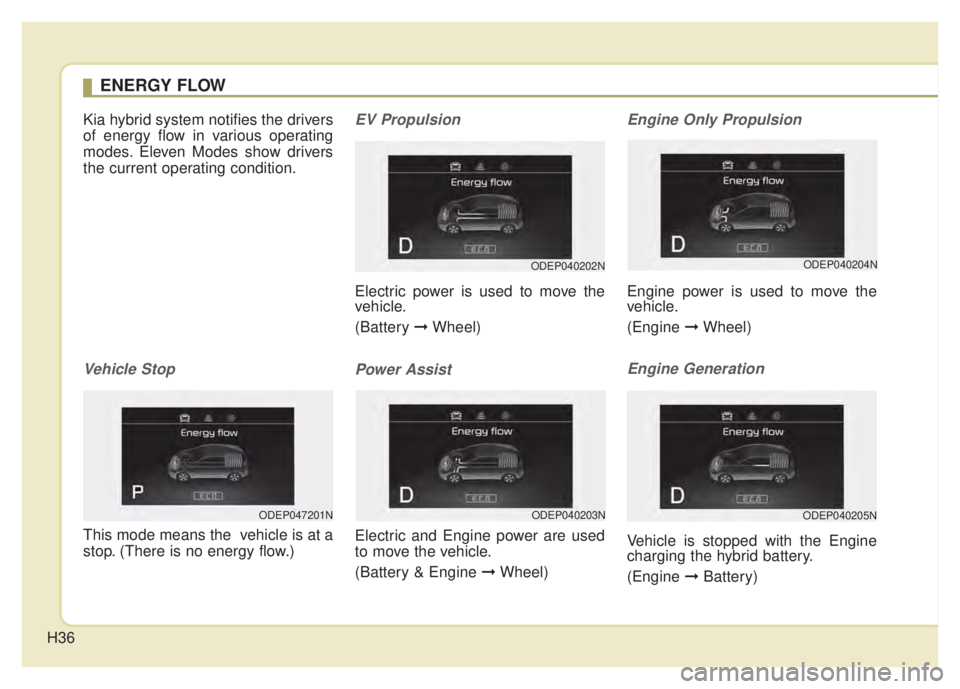
H36
Kia hybrid system notifies the drivers
of energy flow in various operating
modes. Eleven Modes show drivers
the current operating condition.
Vehicle Stop
This mode means the vehicle is at a
stop. (There is no energy flow.)
EV Propulsion
Electric power is used to move the
vehicle.
(Battery ➞Wheel)
Power Assist
Electric and Engine power are used
to move the vehicle.
(Battery & Engine ➞ Wheel)
Engine Only Propulsion
Engine power is used to move the
vehicle.
(Engine ➞Wheel)
Engine Generation
Vehicle is stopped with the Engine
charging the hybrid battery.
(Engine ➞Battery)
ENERGY FLOW
ODEP040202N
ODEP040203N
ODEP040204N
ODEP040205NODEP047201N
Page 42 of 710
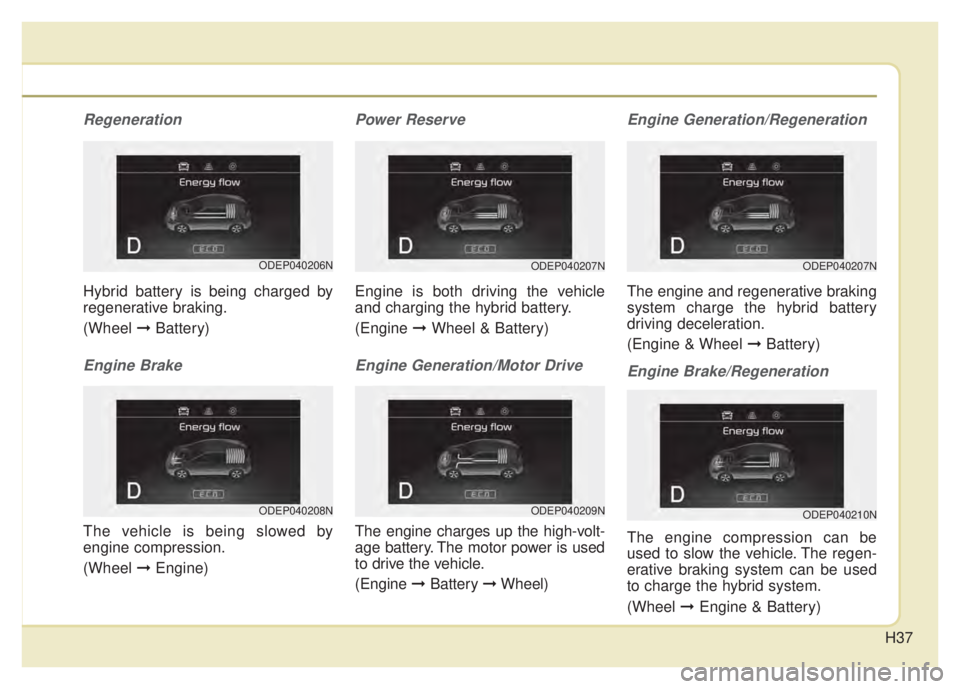
H37
Regeneration
Hybrid battery is being charged by
regenerative braking.
(Wheel ➞Battery)
Engine Brake
The vehicle is being slowed by
engine compression.
(Wheel ➞Engine)
Power Reserve
Engine is both driving the vehicle
and charging the hybrid battery.
(Engine ➞ Wheel & Battery)
Engine Generation/Motor Drive
The engine charges up the high-volt-
age battery. The motor power is used
to drive the vehicle.
(Engine ➞Battery ➞Wheel)
Engine Generation/Regeneration
The engine and regenerative braking
system charge the hybrid battery
driving deceleration.
(Engine & Wheel ➞ Battery)
Engine Brake/Regeneration
The engine compression can be
used to slow the vehicle. The regen-
erative braking system can be used
to charge the hybrid system.
(Wheel ➞Engine & Battery)
ODEP040207N
ODEP040209N
ODEP040207N
ODEP040210N
ODEP040206N
ODEP040208N
Page 43 of 710
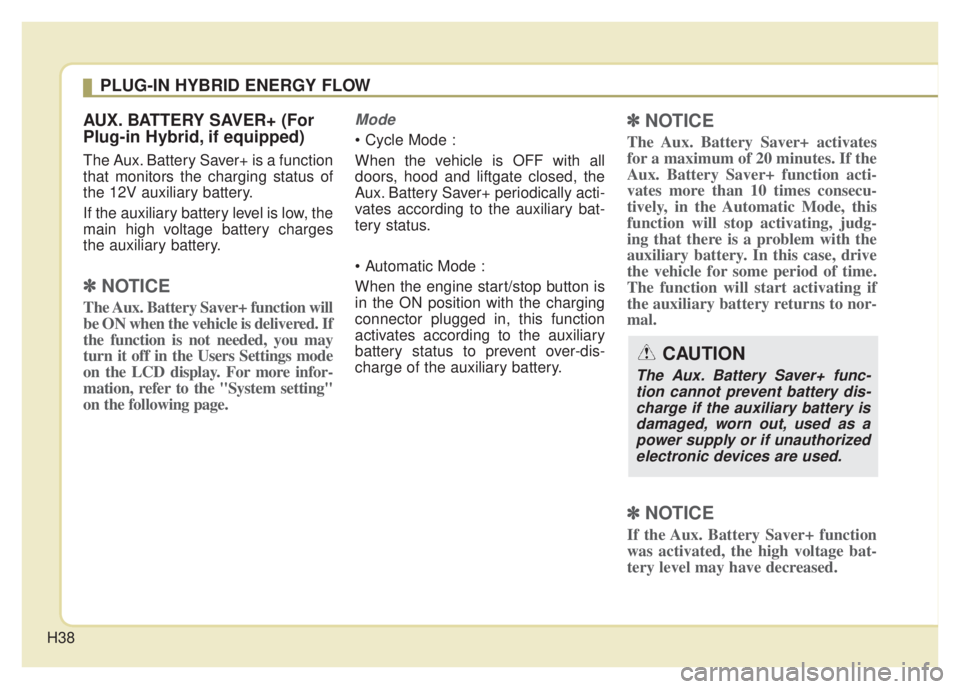
H38
AUX. BATTERY SAVER+ (For
Plug-in Hybrid, if equipped)
The Aux. Battery Saver+ is a function
that monitors the charging status of
the 12V auxiliary battery.
If the auxiliary battery level is low, the
main high voltage battery charges
the auxiliary battery.
✽ ✽NOTICE
The Aux. Battery Saver+ function will
be ON when the vehicle is delivered. If
the function is not needed, you may
turn it off in the Users Settings mode
on the LCD display. For more infor-
mation, refer to the "System setting"
on the following page.
Mode
When the vehicle is OFF with all
doors, hood and liftgate closed, the
Aux. Battery Saver+ periodically acti-
vates according to the auxiliary bat-
tery status.
When the engine start/stop button is
in the ON position with the charging
connector plugged in, this function
activates according to the auxiliary
battery status to prevent over-dis-
charge of the auxiliary battery.
✽ ✽NOTICE
The Aux. Battery Saver+ activates
for a maximum of 20 minutes. If the
Aux. Battery Saver+ function acti-
vates more than 10 times consecu-
tively, in the Automatic Mode, this
function will stop activating, judg-
ing that there is a problem with the
auxiliary battery. In this case, drive
the vehicle for some period of time.
The function will start activating if
the auxiliary battery returns to nor-
mal.
✽ ✽NOTICE
If the Aux. Battery Saver+ function
was activated, the high voltage bat-
tery level may have decreased.
CAUTION
The Aux. Battery Saver+ func-
tion cannot prevent battery dis-charge if the auxiliary battery isdamaged, worn out, used as apower supply or if unauthorizedelectronic devices are used.
PLUG-IN HYBRID ENERGY FLOW
Page 44 of 710
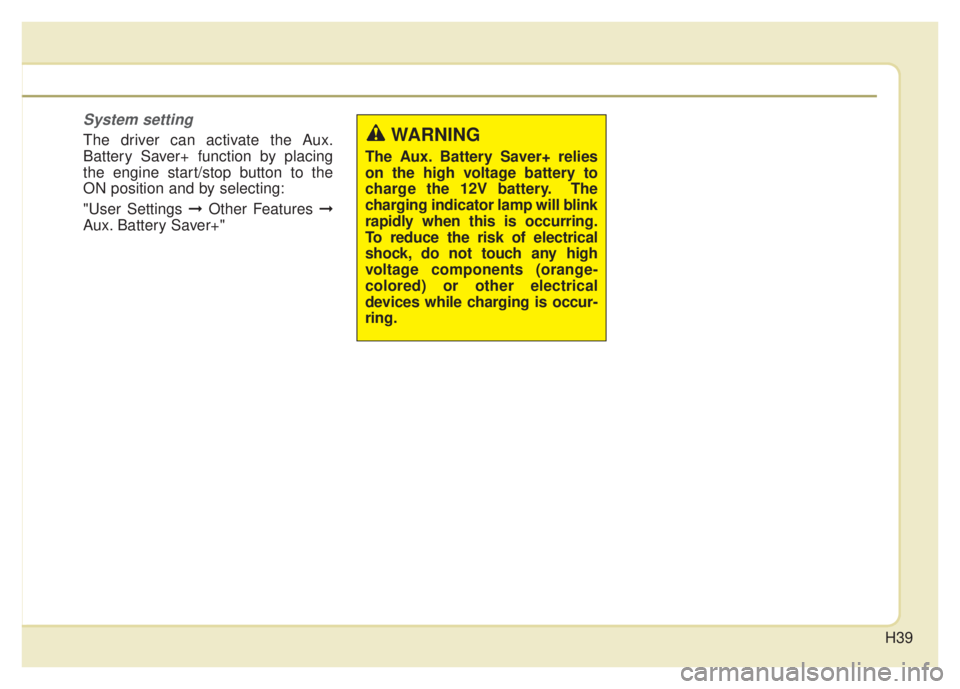
H39
System setting
The driver can activate the Aux.
Battery Saver+ function by placing
the engine start/stop button to the
ON position and by selecting:
"User Settings ➞Other Features ➞
Aux. Battery Saver+"WARNING
The Aux. Battery Saver+ relies
on the high voltage battery to
charge the 12V battery. The
charging indicator lamp will blink
rapidly when this is occurring.
To reduce the risk of electrical
shock, do not touch any high
voltage components (orange-
colored) or other electrical
devices while charging is occur-
ring.
Page 45 of 710
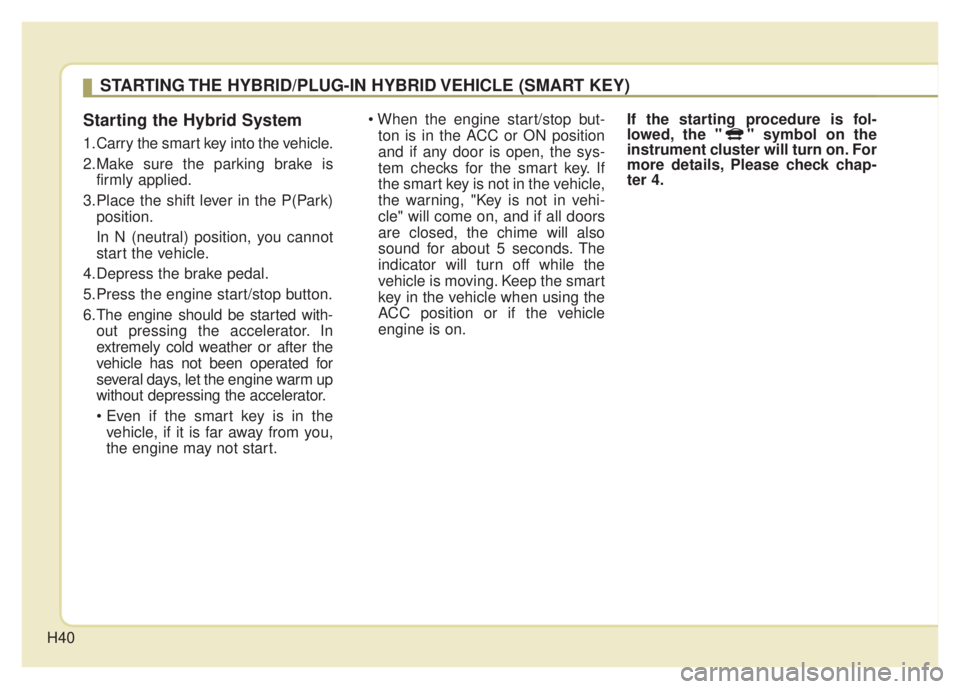
H40
Starting the Hybrid System
1.Carry the smart key into the vehicle.
2.Make sure the parking brake isfirmly applied.
3.Place the shift lever in the P(Park) position.
In N (neutral) position, you cannot
start the vehicle.
4.Depress the brake pedal.
5.Press the engine start/stop button.
6.The engine should be started with- out pressing the accelerator. In
extremely cold weather or after the
vehicle has not been operated for
several days, let the engine warm up
without depressing the accelerator.
vehicle, if it is far away from you,
the engine may not start.
ton is in the ACC or ON position
and if any door is open, the sys-
tem checks for the smart key. If
the smart key is not in the vehicle,
the warning, "Key is not in vehi-
cle" will come on, and if all doors
are closed, the chime will also
sound for about 5 seconds. The
indicator will turn off while the
vehicle is moving. Keep the smart
key in the vehicle when using the
ACC position or if the vehicle
engine is on. If the starting procedure is fol-
lowed, the " " symbol on the
instrument cluster will turn on. For
more details, Please check chap-
ter 4.
STARTING THE HYBRID/PLUG-IN HYBRID VEHICLE (SMART KEY)
Page 46 of 710

H41
ECONOMICAL and SAFE
OPERATION of Hybrid system
Drive smoothly. Accelerate at amoderate rate and maintain a
steady cruising speed. Don't make
"jack-rabbit" starts. Don't race
between stoplights.
Avoid heavy traffic whenever pos-
sible. Always maintain a safe dis-
tance from other vehicles so you
can avoid unnecessary braking.
This also reduces brake wear.
The regenerative brake generates energy when the vehicle deceler-
ates.
When the hybrid battery power is low, the hybrid system automatical-
ly recharges the hybrid battery.
When the engine runs in "N" posi- tion, the hybrid system cannot gen-
erate electricity. The hybrid battery
cannot recharge in "N" position.
Please refer to chapter 6.
✽ ✽ NOTICE
When the hybrid system is in ready
mode, the engine will automatically
start and stop as needed.
The " " symbol will illuminate in
the cluster when the system is oper-
ational.
CAUTION - Extended
cranking
Do not crank the engine for aprolonged period of time with-out the engine starting. Thiscould result in damage to theHEV battery and result in totaldischarge.
Page 47 of 710

H42
COMPONENTS OF THE HYBRID/PLUG-IN HYBRID VEHICLE
1. Engine : 1.6L
2. Motor : 32kW (HEV)/ 44.5kW (PHEV)
3. Transmission : 6DCT
4. Hybrid starter generator (HSG)5. HPCU (Hybrid Power Control Unit)
6. High voltage battery system
7. Regenerative brake system
8. Virtual Engine Sound System (VESS)
ODEPQ011001L❈
The actual shape may differ from the illustration.
Page 48 of 710
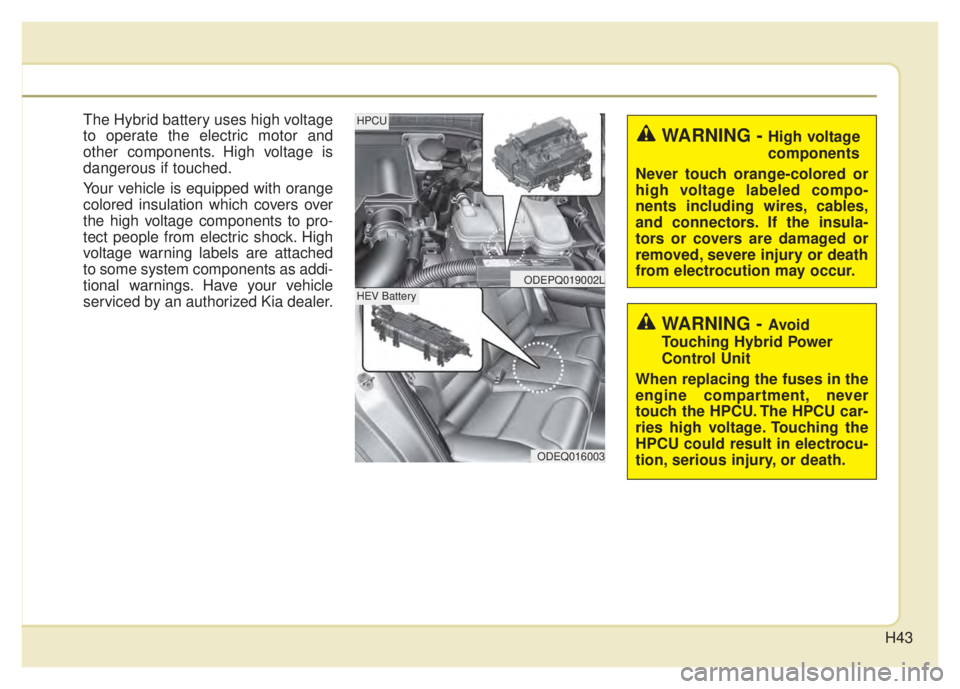
H43
The Hybrid battery uses high voltage
to operate the electric motor and
other components. High voltage is
dangerous if touched.
Your vehicle is equipped with orange
colored insulation which covers over
the high voltage components to pro-
tect people from electric shock. High
voltage warning labels are attached
to some system components as addi-
tional warnings. Have your vehicle
serviced by an authorized Kia dealer.
WARNING - High voltage
components
Never touch orange-colored or
high voltage labeled compo-
nents including wires, cables,
and connectors. If the insula-
tors or covers are damaged or
removed, severe injury or death
from electrocution may occur.
WARNING - Avoid
Touching Hybrid Power
Control Unit
When replacing the fuses in the
engine compartment, never
touch the HPCU. The HPCU car-
ries high voltage. Touching the
HPCU could result in electrocu-
tion, serious injury, or death.
ODEPQ019002L
ODEQ016003
HPCU
HEV Battery
Page 49 of 710

H44
WARNING - Battery elec-trolyte
As with all batteries, avoid fluid
contact with the Hybrid battery.
If the battery is damaged and if
electrolyte comes in contact
with your body, clothes or eyes,
immediately flush with a large
quantity of fresh water and seek
medical attention.
WARNING - After market
battery charger
Do not use an after-market bat-
tery charger to charge the
Hybrid battery. Doing so may
result in death or serious injury.
WARNING - High Waters
Avoid high waters as this may result in your vehicle becom-
ing saturated with water and
could compromise the high
voltage components.
Do not touch any of the high voltage components within
your vehicle if your vehicle
has been submerged in water
equal to half of the vehicle
height. Touching high voltage
components once submerged
in water could result in severe
burns or electric shock that
could result in death or seri-
ous injury.
ODEQ016004
MotorCAUTION - High Voltage
Battery Damage
When loading your vehicle, be careful of transporting items ina manner that could damage thehigh voltage battery. Do notstore items on top of the highvoltage battery or overload thetrunk area. Such actions mayultimately damage the high volt-age battery unit.
CAUTION - Carrying
Liquids in Trunk
Do not load large amounts of liquid in open containers in thevehicle. If spilled onto the HEVbattery, the liquid may cause ashort or further damage to thebattery.
COMPONENTS OF THE HYBRID/PLUG-IN HYBRID VEHICLE (CONT.)
Page 50 of 710

H45
✽ ✽NOTICE - Prolonged parking
Prolonged parking might cause bat-
tery discharge and operation failure
due to natural discharge. Driving
the vehicle approximately once
every 2 months, more than 9 miles
(15 km) is recommended. The bat-
tery will be charged automatically
when driving the vehicle.
WARNING - Exposure to
High Voltage
High voltage in the hybrid bat- tery system is very dangerous
and can cause severe burns
and electric shock. This may
result in serious injury or death.
For your safety, never touch, replace, dismantle or remove
any portion of the hybrid bat-
tery system including compo-
nents, cables and connectors.
WARNING - Use of Water
or Liquids
If water or liquids come into
contact with the hybrid system
components, and you are also
in contact with the water, severe
injury or death due to electrocu-
tion may occur.
WARNING - Hot
Components
When the hybrid battery system
operates, the HEV battery system
can be hot. Heat burns may result
from touching even insulated
components of the HEV system.
CAUTION - Cleaning
Engine
When you clean the engine com- partment, do not wash usingwater. Water may cause electricarcing to occur and damage elec-tronic parts and components.